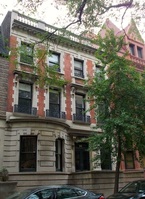Brooklyn 101 introductory tour (3 hours)
A brisk 3-hour visit to DUMBO, Brooklyn Heights, Park Slope, and Prospect Park, with a bit of Downtown Brooklyn and a peek at the Brooklyn Museum, introduces the borough's history, architecture, landscape, and lore.
 Park Slope's best block Park Slope's best block
This is a 3-hour sampling in a huge borough, aimed at a small group able to walk briskly. For a somewhat more extensive introduction, which expands on Brooklyn 101, see Brooklyn 202.
If you want a 2.5-hour tour or have a larger group or one that can't move briskly, we'd do the first half of Brooklyn 101, DUMBO and Brooklyn Heights, but won't have time to get to Park Slope and Prospect Park. Instead, we'd extend either south of Brooklyn Heights to see a piece of Cobble Hill and Carroll Gardens or east to see more of Downtown Brooklyn and possibly a bit of Fort Greene. What is Brooklyn about? What neighborhoods are emblematic of the borough's revival (and decreasing affordability)? How do architecture and parks, retail and transportation, civic buildings and the arts fit into the borough? What are signs of Brooklyn's past, from a private club to the first Black major league baseball player? Let's explore some classic neighborhoods. We start in DUMBO (Down Under the Manhattan Bridge Overpass), this former waterfront factory zone that has been dramatically buffed into Brooklyn's hottest neighborhood. (Alternatively, we can do the tour "backwards," and meet near Brooklyn's magnificent Grand Army Plaza, the psychic center of Brooklyn, or the nearby Brooklyn Museum. That allows us to end in DUMBO.) We'll stroll into Brooklyn Heights, the city's first historic district and still a vital (and prosperous) residential neighborhood, with row houses, Brooklyn's most famous (abolitionist) church, former hotels, and generations of apartment buildings. At the Brooklyn Heights Promenade, we find glorious views of the Manhattan skyline, New York Harbor, and the Brooklyn Bridge. We'll reach the institutional heart of Brooklyn, home of Borough Hall, Brooklyn's old City Hall, and see part of Downtown Brooklyn: government buildings, early 20th-centery skyscrapers, and a riot of new development, spurred in the last two decades. Brooklyn tour highlightsWe then travel by subway to the Brooklyn Museum, see its imposing facade and maybe enter the vestibule. (If we extend the tour, sometimes we visit into the museum--for a fee--and see Judy Chicago's mesmerizing feminist work, The Dinner Party.)
We'll continue past the Brooklyn Botanic Garden to the Brooklyn Public Library's Central Library, which typically has local art or photography exhibits, and enter, if it's open. We'll step into Brooklyn's most famous park, Prospect Park, a cousin to and contrast with Olmsted & Vaux's earlier Central Park, and see the Soldiers and Sailors Memorial Arch. On Saturdays, there's a Greenmarket outside the park, opposite the arch. Then we'll explore the marvelous architecture in the "gold coast" of Park Slope, the city's most livable neighborhood (according to New York magazine), While exemplifying gentrification, Park Slope also boasts the country's largest co-operative grocery, a sign of long-standing civic activism. Numerous places to eat or snack are nearby, as are possible tour extensions. (An alternative: we can start the second half of the tour in Park Slope, and end at the Brooklyn Museum or Brooklyn Botanic Garden.) |
Distance from Midtown Manhattan: 20-25 minutes by subway to DUMBO, 25-35 minutes if we start in Park Slope.
Cost: see fees here Basic tour length: About 3 hours (see fees). Yes, this tour is ambitious. It includes a bathroom stop and a subway ride. Starting place: In DUMBO, F train to York Street. Or meet after you exit the Brooklyn Bridge, or exit the ferry terminal. In Park Slope or Prospect Heights, B/Q to Seventh Avenue, 2/3 to Grand Army Plaza or Brooklyn Museum. Ending place: Varies, but typically either near the Brooklyn Museum or in Park Slope if we start in DUMBO. If we don't, we end in DUMBO.. Highlights: History, architecture, waterfront views, parks, arts institutions, civic life. Before tour: Walk the Brooklyn Bridge. Snack in DUMBO. Or, if we start deeper in Brooklyn, you can visit the Brooklyn Museum or Brooklyn Botanic Garden. After tour: See "before tour" options above. If we end in DUMBO, you can take NYC Ferry to Wall Street, Williamsburg, and more.. Potential tour extensions with me: Brooklyn 202, Williamsburg, Crown Heights, Brooklyn Bridge, Atlantic Avenue, Prospect Heights neighborhood Why I like leading this tour: Brooklyn is too big to see even in three hours , but I'm confident this offers both breadth, variety, and history (+trees and views) to show you the most possible within time constraints. |